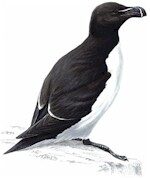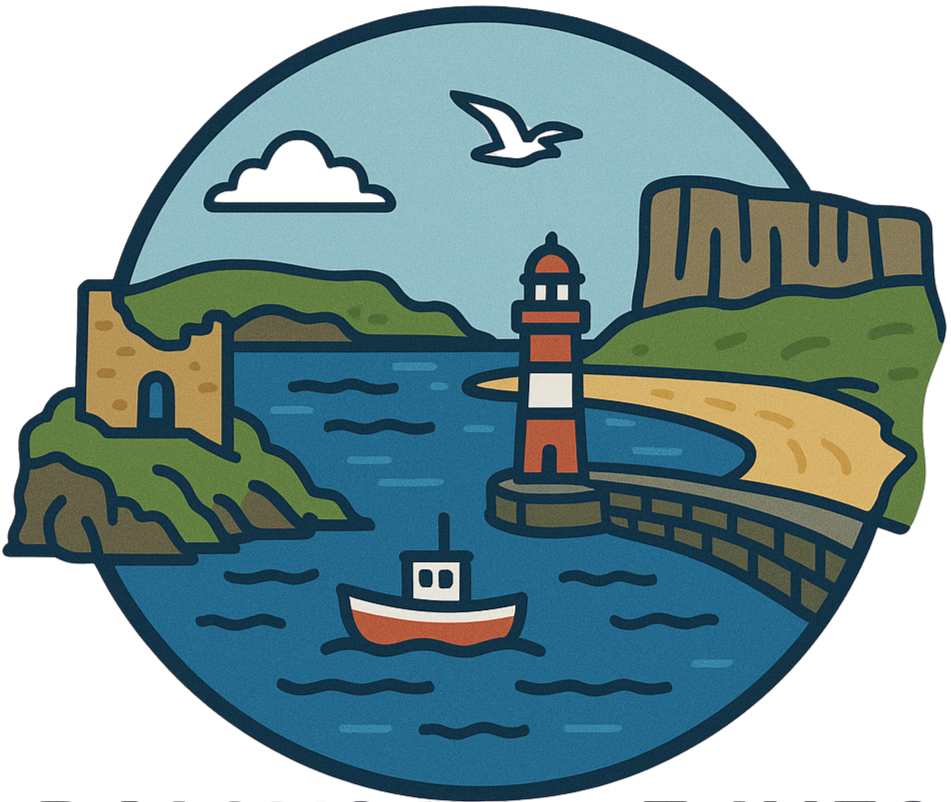

Map
More Images
Rathlin is a small, L -shaped island about 1400 hectares in area and is situated five miles (8km) off the Antrim coast just north of Ballycastle from where the 45 minute ferry journey begins. The island is inhabited by about 100 residents whose ancestors have resided on Rathlin for hundreds of years, and many a yarn they will tell you about the islands history. Rathlin has spectacular cliff top walkways, caves and ample wild nature to view making it very popular with birdwatchers, geologists, botanists, divers, anglers and anyone with a passion for wild and rugged scenery. Search for flakes of flint at Brockley, for Rathlin porcellanite axes were the designer weapons of the Stone Age. The island is also quite famous for Bruce’s Cave that is blow the East lighthouse where Robert The Bruce was said to have sought refuge in 1306 after his defeat by the English at Perth in Scotland. As he sat in the cave he caught sight of a spider that repeatedly tried to reach the cave roof by its thread, it eventually succeeded. He concluded, ‘If at first you don’t succeeded, try try and try again’, returned to Scotland and defeated the English at Bannockburn.
The ferry can transport cars onto the island but only by special permission and hence there are very few cars making the roads very quiet and ideal for walking. There is a minibus service from the harbour to the bird sanctuary, but if you are up to a five mile walk it is well worth the effort.
Birds – RSPB
The RSPB nature reserve is a stretch of basalt cliff along the north coast of Rathlin. To make access to this area safe the RSPB leases the viewpoint at the West Lighthouse from the Commissioners of Irish Lights. This viewpoint, which can be seen as the white building in the above image, provides spectacular views of Northern Ireland’s finest bird colony. Guillemots and Kittiwakes nest in their thousands along the steep cliffs whilst the offshore stacks is a safe haven for Razorbills, Fulmars and Puffins.
Peregrine Falcons, Kestrels, Buzzards, Ravens, Wheatears and Stonechats can often be seen and Skylarks may be heard along the road. Amongst the freshwater marshes you may see breeding Lapwings, Snipe, Sedge Warblers, Reed Buntings and Black-Headed Gulls. Church Bay also plays host to Eiders, Ringed Plovers and Oystercatchers, whilst Black Guillemots breed at cliff bases. Walk on from Church Bay towards the Rue Point and pass small loughs, home to Grebes, Tufted Ducks, Moorhens and Coots. Other birds that may be seen on your visit to the island would be Blackbird, Chaffinch, Chiff-Chaff, Chough, Coal Tit, Common Gull, Common Sandpiper, Cormorant, Corncrake, Crossbill, Curlew, Dunlin, Dunnock, Gannets, Goldcrest, Goldfinch, Great Black-Backed Gull, Greenfinch, Herring Gull, Hooded Crow, House Martin, House Sparrow, Jackdaw, Lesser Black-Backed Gull, Linnet, Long-Eared Owl, Magpie, Mallard, Manx Shearwater, Meadow Pipit, Mistle Thrush, Pied Wagtail, Purple Sandpiper, Redpoll, Redshank, Robin, Rock Dove, Rock Pipit, Rook, Shag, Shelduck, Song Thrush, Sparrowhawk, Spotted Flycatcher, Starling, Swallow, Teal, Turnstone, Twite, Water Rail, Whinchat, Whitethroat, Willow Warbler, Wren.
Other Wildlife
Irish hares and rabbits are most easily seen but if you make your way the Mill Bay or the old Smuggler’s house at the Rue Point you should be able to see both grey and common seals at fairly close quarters.
History
The Axe Export
It is believed that man first set foot on Rathlin around 6000-5000BC on his way to Whitepark bay in the Middle Stone Age. Evidence has been found to support these findings in the form of auk, bear, elk and many types of fish and shellfish. Evidence also shows that by about 2500BC Rathlin had built up an Axe export trade. These axes made from a fine blue stone known as ‘Porcellanite’ found in the Brockley town land located towards the west of Rathlin. There was only two other such locations in Ireland and this led to distribution throughout the UK. This trade also attracted trading ships from as far as Crete / Tyre and Rathlin Islanders would have been quite wealthy, the young boys would have traveled on these ships to locations such as Egypt. The climate about this time would have had a much milder climate similar to that of the Mediterranean making it much safer to cross the sea in the flimsy Curraghs made from wood and animal skin.
Sadly, around 1800BC Copper axes appeared and the trade dried up within a few years. Rathlin an island that had been well known and well informed on world issues fell into an era of obscurity since the trade ships no longer visited with tales of far off lands. About 1500BC the island was occupied by the Firbolgs, a small dark Spanish race translating to ‘bag men’ that may be a reference to wearing ‘woven trousers’. Their reign did not last long as about 1200BC they were driven out by the ‘Tuatha de Doman’, swords of Bronze.
Next to arrive about 400BC, the Celts who again struck terror with their swords of Iron. Tall with red blonde hair and considerable artistic genius these people settled here for over 1200 years. There have been a few iron age burial sites found and it is said that these contained the swords of iron when first discovered. During the first century the island was ruled by King Donn who had a daughter called ‘Taisie’ that is said to have been the most beautiful woman in the world with her dazzling blue eyes and long curling tresses.
Saint Patrick
Around 400AD the Roman Empire was in steady decline from England and during this time Niall a splendid hero of Gaelic blood, sent many incursions across the Irish sea in Curraghs. One of these raids was to be legendary in the history of Ireland when Niall kidnapped several people, one of whom was the son of a minor Roman official. Saint Patrick as he became known had such an effect on religion that soon monasteries appeared on many islands including Rathlin which followed the trend 200 years later. 795AD the Vikings arrived raiding the monasteries for their gold hoards. The monks won in the end when most of the raiders followed the Christian faith.
1100AD the island came under the rule of the Argyll chieftain Somerled a great chieftain from whom the notorious MacDonnells of Antrim would eventually descend. 1156AD the Norwegians fought and gained ownership of the island amongst others.
The next few decades were to prove quite turbulent in Rathlin’s history when in 1169 Henry II King of England gave land grants over the island to John De’Courcy whom it is beleived built the castle known as ‘Bruces’, he had built several such buildings in the immediate area during his stay. The island then fell into the hands of one Hugh De’Lacy in 1205 when he turned King John against De’Courcy, but this did last long as he grew too greedy and De’Courcy returned with King John’s consent to expel De’Lacy. After King John had finished his purge of Ulster he granted land rights to Duncan of Carrick who in turn granted it to his kinsman Alan Earl of Galloway. This only lasted for three years until 1216 when King John intervened again to grant ownership to the De’Lacy family yet again only for it to be inherited by the De’Burgos by marraige.
In 1242 the Byssets arrived from Scotland and bought Rathlin and the Glens from the De’Burgos. It was during this period that it is claimed that Sir Hugh Bysset let Robert the Bruce hide in the autumn of 1306 after defeat by the English. Whilst he stayed on the island the Bruce is said to have drawn new inspiration after watching a spider finally succeed after several attempts to climb to the roof inside what is now commonly known as Bruce’s cave.
The McDonnells The island then changed ownership by the marriage of Margery Bysset to John Mor McDonnell and would remain in the McDonnell family name until 1490 when Angus McDonnell was assassinated and in 1493 King James IV forfeited the title ‘Lord of the Isles’ and ruled the island. After this date details are scarce as the McDonnells were not akin to keeping records. The McQuillans are said to have had influence over the island during this period although there is no proof.
Anyway it wasn’t until 1551 that Rathlin once more got into the thick of it. Captain Cuffe and Sir Ralph Bagenal tried to land near Bruce’s cave to defeat Colla and James McDonnell, but the ship was thrown ashore by the unpredictable swell and both were captured and later released in exchange for the release of Sorley Boy. The island suffered a massacre in 1557 at the hands of Sir Henry Sydney when he captured corn and cattle. Turlough Luineach O’Neill married Lady Agnes Campbell (James McDonnell’s widow) with fourteen days of story-tellers, jugglers and jesters. The next big massacre was by Sir Francis Drake when he conned the people into surrendering only to be slaughtered, but revenge was swift by Sorley Boy by the capturing the castle at Carrickfergus when he killed over a hundred. The English didn’t think the island was worth holding so Sorley Boy reacquired it shortly and used it as a base for raids on the mainland against the English. In 1585 Henry Bagenal and Captain Thorton recaptured the island after some sharp fighting by Sorley Boy and his men near Dunmore before the beat a hasty retreat to Kintyre. Sorley Boy then captured Dunluce castle and swore allegiance to Queen Elizabeth in return for land rights he so rightly deserved. This drew to an end the long conflict between the Scots and the English in the area.
Irish or Scottish
After Elizabeth’s death the Stuart monarchy granted a knighthood to Sorley Boy’s son Randal and the grants of Rathlin and The Glynns. For a while the island was peaceful although the issue of whether the island belonged to Ireland or Scotland came into focus when the right of ownership was disputed by Crawford of Lisnorris. Luckily for Randal the court ruled in his favour and Rathlin was proclaimed an Irish island.
too be continued…
Mary Black, the famous Irish singer came from here.

